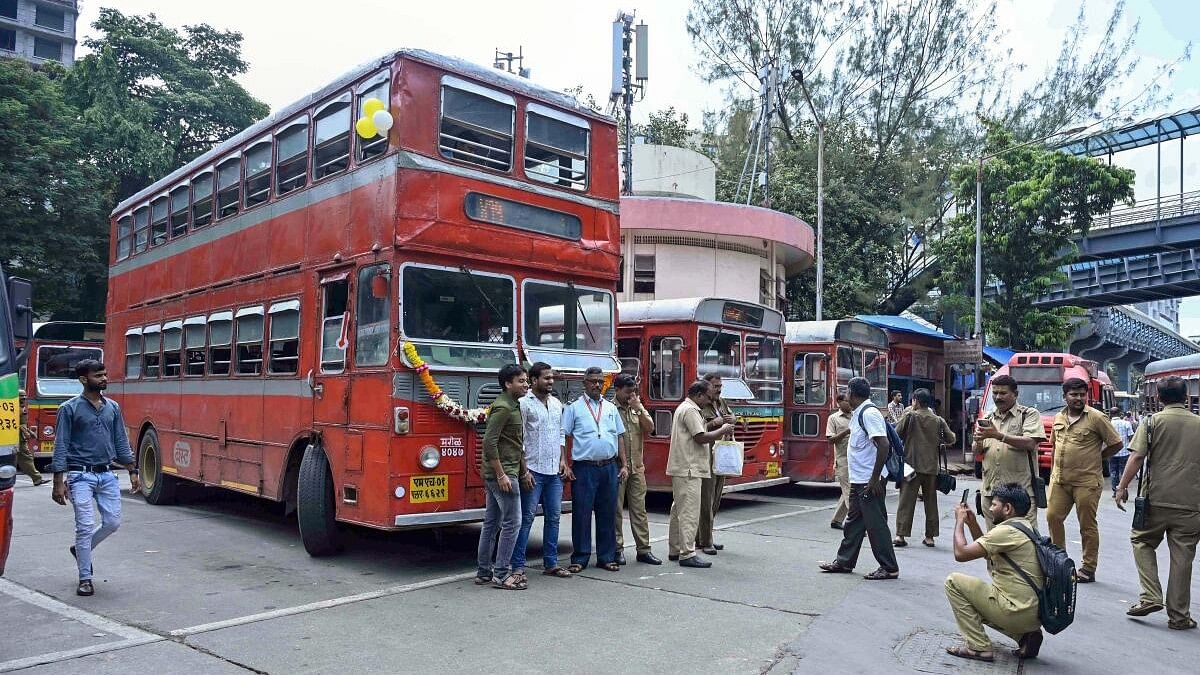
A file image of BEST buses.
Credit: PTI Photo
Mumbai: It moved Mumbai, then Bombay, literally on 'horse power', transitioned to buses running on diesel and embraced less-polluting compressed natural gas or CNG before introducing sleek and silent electric vehicles with zero emission.
This has been the journey of the Brihanmumbai Electric Supply and Transport (BEST) since May 9, 1874, which completed 150 years on Thursday.
With a fleet of over 3,000 buses today, the mass transit body ferries about 32 lakh commuters a day, up from 6 lakh in 1926, though losses have crept in.
About 20 years after the country’s first train ran between CSMT (then Boribunder) and Thane on April 16, 1853, the Bombay Tramways Company launched the first horse-drawn tram service, giving the city another mode of public transport.
Until then, horse-pulled ‘Shigram’ and bullock-drawn ‘rekla’ were being used for local transportation, as per the book ‘The BEST Story’.
“The service first started on two routes: Colaba to Pydhoni via Crawford Market, and Bori Bunder to Pydhoni, via Kalbadevi. That was on 9th May 1874. The fare from Colaba to Pydhoni was three annas. The fare was brought down to two annas; it dropped down to one anna (about one-sixteenth of a rupee) in 1899,” according to the book.
The service was started with a fleet of 20 cars and 200 horses. When it closed down in 1905, it had 1,360 horses, says the book. The first electric tram service in the city was launched about two years later.
In the early 1900s, the BEST Tramways Company was renamed BEST Electric Supply and Tramways Company Limited (BEST), which decades later got the name Brihanmumbai Electric Supply and Transport (BEST) undertaking.
“The passing years aggravated the problem of rush-hour traffic. The solution next thought of was the double-decker tram car. It was accepted, and the first vehicles of the kind appeared on Mumbai's roads in September 1920,” the book reads.
Besides electric trams, BEST introduced a fossil fuel-run bus service between Afghan Church and Crawford Market on February 15, 1926.
“In its first year, that is by December 31, 1926, about six lakh passengers used the service; for 1927, the figure was about 38 lakh. The Company started its operations with 24 buses. In 1927, the fleet had expanded to 49,” the book reads.
The double-decker bus, popularised even more by Bollywood in the last century, was born of practicality. A single-decker bus carried only 36 passengers, while two decks could hold 58 of Bombay's burgeoning passenger crowd. On December 8, 1937, the first double-decker BEST bus was driven onto the streets of the city, says the book.
“Today, the BEST bus is ubiquitous but its origins lie in another transportation system that is now defunct,” said Bharat Gothoskar, city chronicler and founder of KHAKI Heritage Foundation, adding that the trams were finally closed down in 1964 due to traffic congestion.
As per books on BEST's history, the red bus undertaking had also launched a “trolley bus service” and “articulated double-decker buses” that were operational for several decades. Besides running services on roads, BEST even ventured into water transport.
“Cognisant of their role in enabling journeys for the people of Mumbai at all times, BEST innovated another first: quick ferry services from Marve Beach in Malad to Manori Beach, a popular family destination known for excellent seafood,” according to a coffee table book published by BEST in 2022.
Today, BEST buses are the second biggest mode of public transport in Mumbai, after the suburban locals, which ferry around 70 lakh commuters daily.
The undertaking has a fleet of 3,051 buses, including 561 battery-powered ones, ferrying around 32 lakh passengers a day in Mumbai and neighbouring Navi Mumbai, Thane and Mira-Bhayander, said BEST spokesperson Sunil Vaidya.
BEST also supplies power to its 10.5 lakh consumers in the island city of Mumbai, he said.
Vaidya said they have planned to replace all fossil fuel-powered buses with eco-friendly e-buses.
The undertaking has placed orders for 5,000 buses, including 200 AC double-deckers of which 50 are already plying in the city.
BEST officials said they have kept the sesquicentennial anniversary celebrations lowkey as the model code of conduct is in force due to the ongoing Lok Sabha elections.
Except for an exhibition at its Anik Depot-based museum, no other programme has been organised, said an official.
Suhas Nalawade, labour union leader and former assistant general manager of BEST, told PTI that the undertaking was the lifeline of Mumbai till the last century.
It was considered one of the best public transport bodies in Asia. It was so efficient then, with a fleet of less than 3,000 buses, that it used to ferry around 40-45 lakh passengers daily between 1991 and 1995, he said.
“BEST had a glorious past before 2003 until the operational loss of the transport wing was mitigated by its power wing surplus. Due to mounting operational losses, the situation of the undertaking has become pitiable now and it has no money to pay even the legitimate dues of its retired employees,” Nalawade said